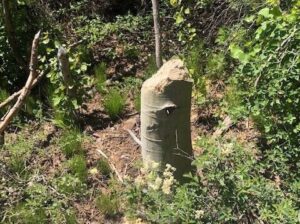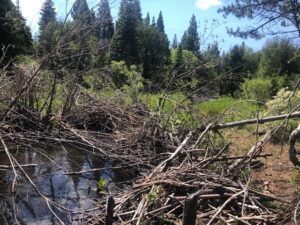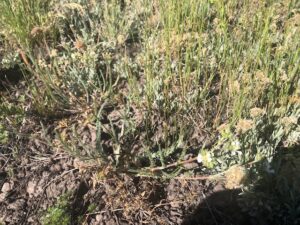FOREST FLASH
Summer Double – August #1
In Pacific Forest Trust’s e-newsletter, Forest Flash, we send you the most recent PFT news and updates on forests, clean water, climate, and wildlife. Subscribe here.
 Oregon had a turbulent, but remarkably productive, legislative session! Hampered by walkouts, it was unclear what outcomes might be able to be rescued. However, with real resolve and leadership, Oregon emerged from the 2023 legislative session with significant policy wins for the climate and water. The Natural Climate Solutions bill (SB 530), passed as part of the omnibus Climate Budget Framework, creates a $10 million Natural and Working Lands Fund to provide incentives for the adoption of conservation practices that enhance carbon sequestration on the state’s natural and working lands. In addition, the Source Water Protection bill (HB 2813) establishes a new $5 million program at the Oregon Watershed Enhancement Board (OWEB) that will provide grants to water suppliers to protect, restore, or enhance sources of drinking water.
Oregon had a turbulent, but remarkably productive, legislative session! Hampered by walkouts, it was unclear what outcomes might be able to be rescued. However, with real resolve and leadership, Oregon emerged from the 2023 legislative session with significant policy wins for the climate and water. The Natural Climate Solutions bill (SB 530), passed as part of the omnibus Climate Budget Framework, creates a $10 million Natural and Working Lands Fund to provide incentives for the adoption of conservation practices that enhance carbon sequestration on the state’s natural and working lands. In addition, the Source Water Protection bill (HB 2813) establishes a new $5 million program at the Oregon Watershed Enhancement Board (OWEB) that will provide grants to water suppliers to protect, restore, or enhance sources of drinking water.
Finally, HB 3464, A.K.A. the Beaver Believer bill, removes the “predatory animal” status for beavers in Oregon and paves the way for better beaver management that promotes coexistence rather than extermination. PFT actively supported and advocated for these bills, and we are thrilled at their success. The next step, after celebrating these wins and thanking our legislative champions, is engaging in the rulemaking processes to ensure these new policies are ecologically grounded and both support and sustain a resilient, climate adaptive future.
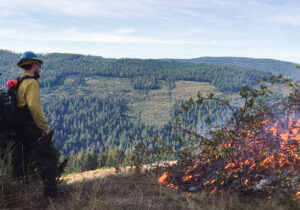 Over the past several years, PFT has been building and leading a broad working coalition of diverse stakeholders impacted by the negative effects of our current, often catastrophic, fires. Participants range from counties and cowboys to Tribal organizations and environmental activists, from the environmental justice community to forest landowners and managers. Our end goal is to increase the use of beneficial fire while decreasing negative fire impacts, and a key mechanism is through restoring and conserving large landscapes where fire can be managed to maintain essential forest functions while mitigating the health impacts on residents and outdoor workers.
Over the past several years, PFT has been building and leading a broad working coalition of diverse stakeholders impacted by the negative effects of our current, often catastrophic, fires. Participants range from counties and cowboys to Tribal organizations and environmental activists, from the environmental justice community to forest landowners and managers. Our end goal is to increase the use of beneficial fire while decreasing negative fire impacts, and a key mechanism is through restoring and conserving large landscapes where fire can be managed to maintain essential forest functions while mitigating the health impacts on residents and outdoor workers.
Our earlier work in the coalition resulted in a significant increase in fire management budgets. But money alone cannot solve this problem. Recent gains we’ve achieved in this show that promoting the use of ‘beneficial fire’ is rapidly gaining broader support. California adopted a “Strategic Plan for Expanding the Use of Beneficial Fire”, and recently launched a new Claims Fund that will provide up to $2 million in coverage for prescribed fire projects led by a qualified burn boss or cultural practitioner.
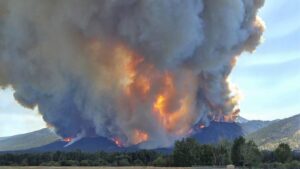 Current foci include removing blockages to getting more good fire on the landscape, such as liability concerns addressed in part through the new Claims Fund, as well as smoke management. While wildfire smoke has negative health impacts, there is “better” than worse fire smoke. The Environmental Protection Agency is currently working to tighten the national standard for small particulate matter in the air, known as PM 2.5—smoke particles fall into this category. While stricter standards make sense for human-caused pollution, it could also make it harder to use beneficial fire (the American Lung Association recognizes that a little bit of smoke from planned fires is far better than the extreme smoke from uncontrolled wildfires). Our coalition is working to show how managed and prescribed fire is a net health benefit and thus merits a different approach under the newly proposed EPA 2.5M rules.
Current foci include removing blockages to getting more good fire on the landscape, such as liability concerns addressed in part through the new Claims Fund, as well as smoke management. While wildfire smoke has negative health impacts, there is “better” than worse fire smoke. The Environmental Protection Agency is currently working to tighten the national standard for small particulate matter in the air, known as PM 2.5—smoke particles fall into this category. While stricter standards make sense for human-caused pollution, it could also make it harder to use beneficial fire (the American Lung Association recognizes that a little bit of smoke from planned fires is far better than the extreme smoke from uncontrolled wildfires). Our coalition is working to show how managed and prescribed fire is a net health benefit and thus merits a different approach under the newly proposed EPA 2.5M rules.
Support PFT’s fire work. Make a gift below.
Summer is a busy, busy season for our stewardship staff. Here is a brief sampling of some highlights from visits to a few of our conserved properties.
California’s Valley View Angus Ranch:
We always look forward to visiting this property in the stunningly beautiful Sierra Valley, a key source of the Feather River and the largest alpine wetland in North America. With terrific winter rain and snow, it’s been a great year for wildflowers! Many of the Property’s riparian areas were lusher and greener than they have been in recent years. Amongst the many signs of wildlife, recent beaver activity was spotted on Hamlin Creek which flows through the property. Both the landowner and PFT see improvements to riparian and water conditions as a result of beavers re-establishing their homes there! And, in a nearby conserved property, we found a plant federally listed as threatened—Plumas ivesia (Ivesia sericoleuca)—which has not been documented in dry years. Topping it off in the Sierra Valley, we heard two pairs of sandhill cranes on a recent visit and had to modify our monitoring route so as not to disturb the breeding pairs!
Oregon’s Alsea River Bend Forest:
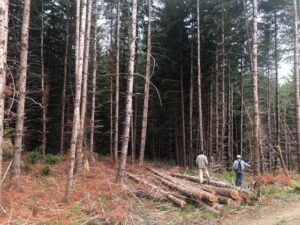
Douglas fir salvage on Alsea River Bend Forest
This was our first annual monitoring visit to PFT’s newest Conservation Easement. Mike and Melissa Haglund, our partner landowners have been busy in storm salvage and thinning operations, and it was great to see these forest management activities occurring on the Property. Our Stewardship staff visited one area where a salvage harvest was occurring to recover primarily Douglas-fir that had been downed by windthrow and the winter’s heavy storms. Wildlife benefits are a key focus for this project, and the landowners are prioritizing snag creation to benefit wildlife utilizing this habitat.
Stewardship can also be hard, nitty gritty work where we must burrow down and focus on metrics to show easement compliance in our conserved properties. One such case this year was our staff measuring 243 stumps in one day to ensure that harvests were staying within agreed limits and that easement goals for large tree establishment were being met! After an arduous day in the hot sun and a lot of bushwhacking, we got all the necessary data needed to now analyze back in a cool office.
ICYMI
In case you missed it (ICYMI), here are some other exciting things PFT has been involved in lately!
-
PFT’s Mt. Ashland Demonstration Forest was featured in a segment from KDRV NewsWatch 12 titled “Forest Preservation and Fire Prevention on Mt. Ashland”
- The Goodnewspaper featured our work to promote restoration of beaver habitat in California in “Home Sweet Home: 5 Habitat Restoration Projects Protecting Biodiversity Around the World.”



